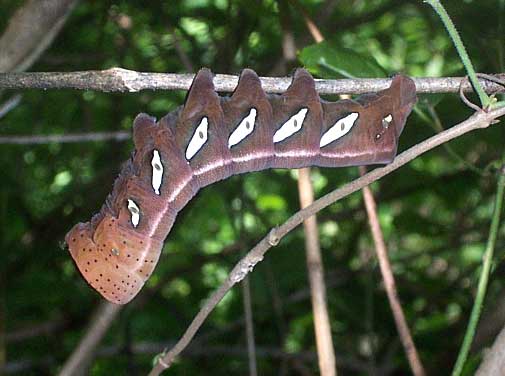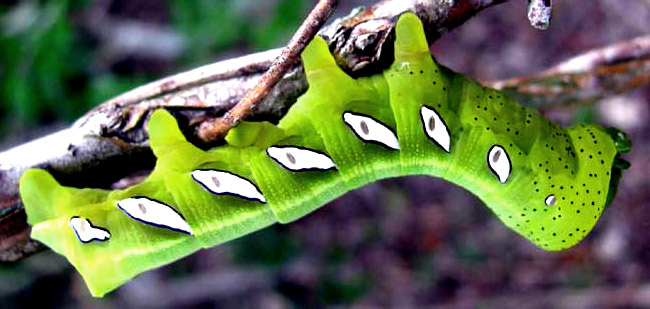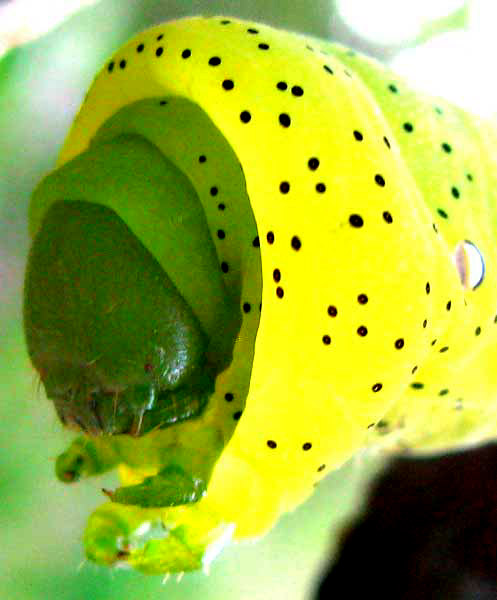Excerpts from Jim Conrad's
Naturalist Newsletter
from the July 27, 2007 Newsletter issued from Hacienda Chichen Resort beside Chichén Itzá Ruins, central Yucatán, MÉXICO
SATELLITE SPHINX MOTH CATERPILLAR
The moment I saw the caterpillar shown below I figured I knew what it was related to:

That larva's finger-length size, thickness and side markings reminded me a lot of the hornworms that used to populate my tomatoes back in Mississippi, despite it bearing no "horn." Hornworms are the caterpillars of sphinx moths so on the Internet I searched for sphinx moth caterpillars. The caterpillar in the above picture turned out to be the larva of the Satellite Sphinx Moth, EUMORPHA SATELLITIA.
The Satellite Sphinx Moth looks like a hummingbird moth, and in fact moths of this family, the Sphingidae, are variously known not only as sphinx moths but also hawk moths and hummingbird moths.
An odd feature of the caterpillar in the picture is its flat-looking head. Actually the larva has a normal, rounded head, but when the larva is disturbed or resting it can withdraw its first three or so segments into its body, like a collapsing telescope.
Satellite Sphinx Moths are distributed from the US border into South America, as well as the Caribbean. The caterpillars are known to eat viny members of the Grape Family. At night female moths emit a "pheromone plume" which males detect and follow to its source. A pheromone is a chemical that triggers an innate behavioral response in another member of the same species, in this case sexual activity.
It's interesting how when you're in a far-away, exotic area you keep meeting "variations on themes" you first learned about in your own home area. I'd never seen a Satellite Sphinx Moth caterpillar before last weekend, but the moment it appeared before me I already knew a lot about it, thanks to my tomato hornworm days in Mississippi.
from the May 16, 2010 Newsletter issued from Hacienda Chichen Resort beside Chichén Itzá Ruins, central Yucatán, MÉXICO
A GREEN ONE
The other day I ran into the pretty caterpillar shown below:

Bea quickly pegged this as a Satellite Sphinx caterpillar, EUMORPHA SATELLITIA, and she further pointed out that a fair number of links to photos of the caterpillar on the Internet... are my own. For, back in Querétaro we ran into this species, though that caterpillar was dark chocolate brown, not green (see above).
Bea also copied from somewhere the following text:
"As the larva approaches maturity it changes to a reddish brown color, and after passing the third moult entirely loses the caudal horn, which is replaced by a glassy eye-like spot. The mature larva when in motion, will measure nearly four inches in length, but when at rest it draws the head and two adjoining segments within the fourth, which shortens its length nearly an inch, giving it a very odd appearance with its anterior portions so blunt and thick."
The Querétaro caterpillar must have been an older one photographed during its later stages of development, while the one found this week was a younger, greener one. Now look at this:

That picture shows some interesting details. For example, note the incurving, sharp-pointed legs below the head. Those are "thoracic legs," the caterpillar's "real" legs, of which there are six, to be contrasted to the more numerous (ten on our caterpillar), much larger "abdominal prolegs" arrayed along most of the caterpillar's length, below.
In the mouth area, notice the downward-pointing thing looking like some kind of electrode emerging from a thick, green base. It's facing the camera's lens head- on. That's an antenna and it has a sense of smell. Notice how it's positioned perfectly to monitor the odor of whatever is being chewed on.
My Maya shaman friend José, seeing the picture, tells me that the Maya name for the green stage translates to the Spanish "Cigarra de Sol," which prettily translates to the English "Sun Cicada."